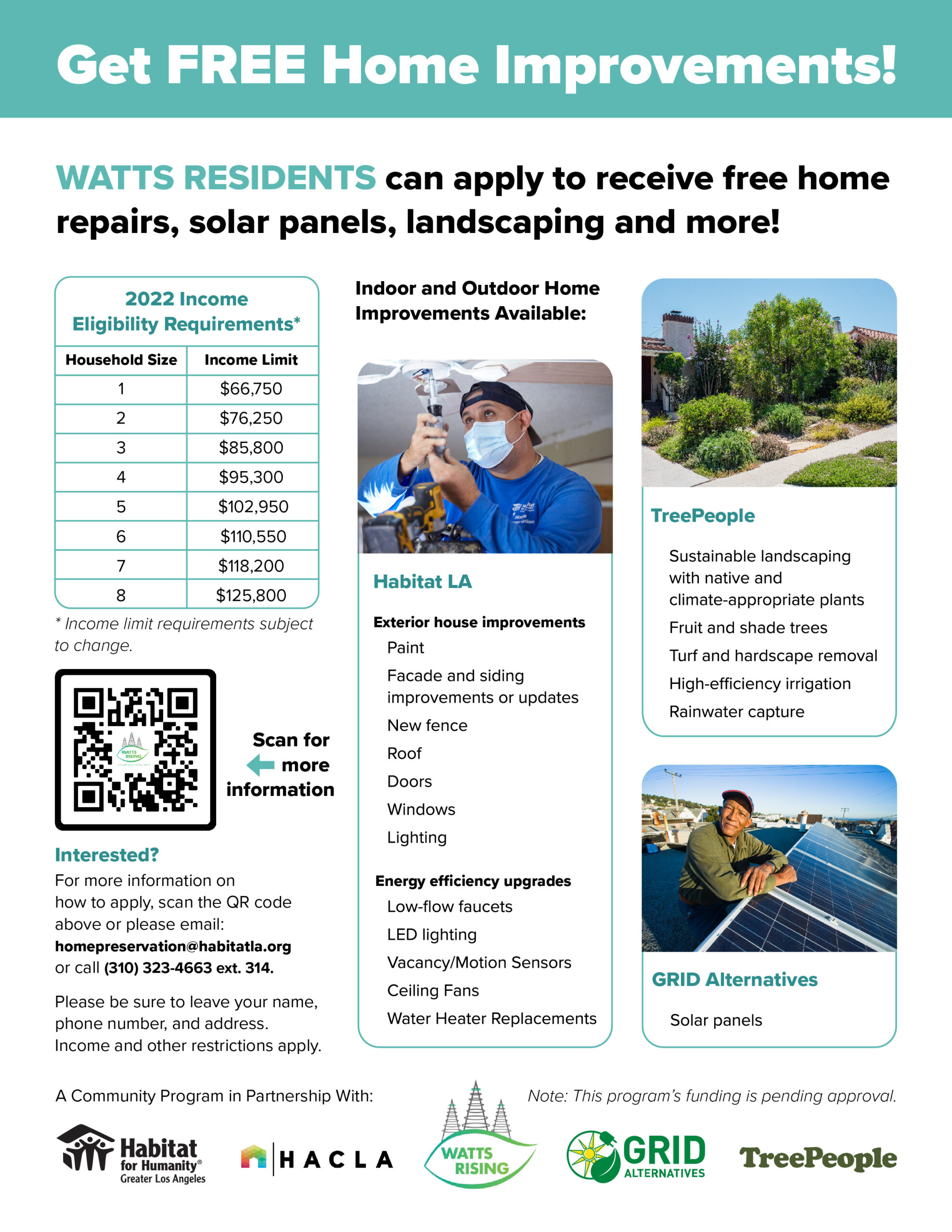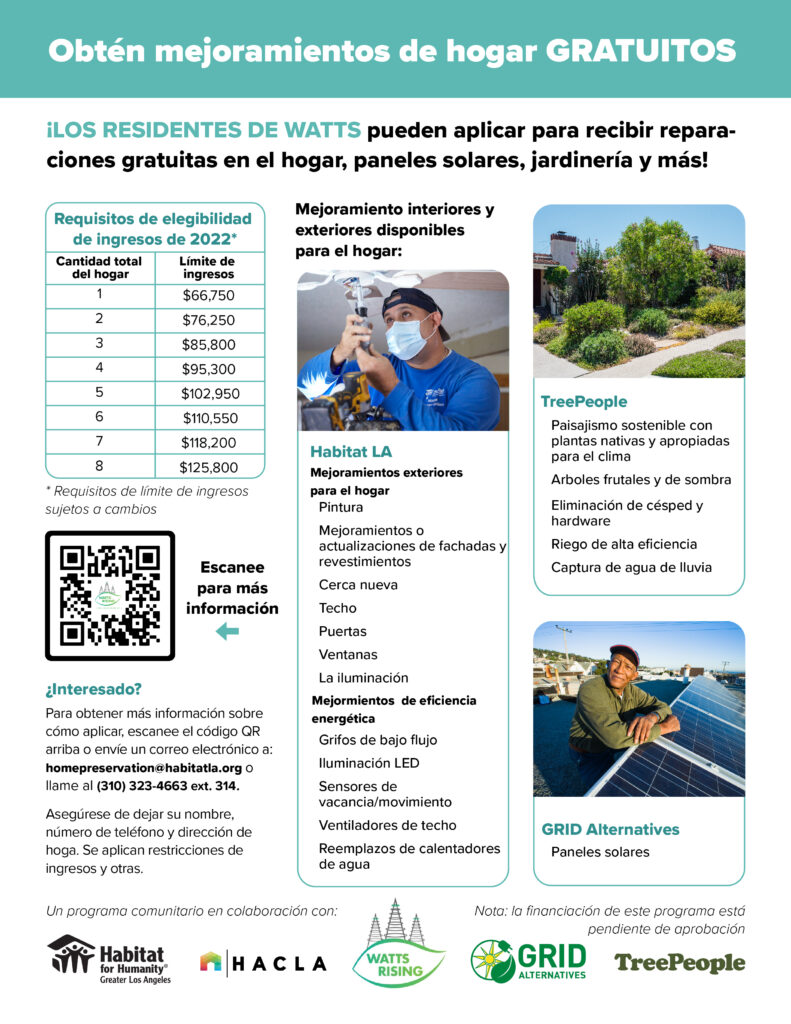
watts-rising domain was triggered too early. This is usually an indicator for some code in the plugin or theme running too early. Translations should be loaded at the init action or later. Please see Debugging in WordPress for more information. (This message was added in version 6.7.0.) in /nas/content/live/wattsrising/wp-includes/functions.php on line 6121UCLA researchers have tracked progress in five communities that have each received tens of millions of dollars from the TCC program: Fresno, Ontario, Stockton, and the Los Angeles neighborhoods of Northeast San Fernando Valley and Watts. Across the communities, there are some common projects — such as the installation of solar panels on low-income homes and improved mobility options for getting around without an expensive and/or polluting car — that allow households to help the environment while helping their pocketbooks.
UCLA researchers have tracked progress in five communities that have each received tens of millions of dollars from the TCC program: Fresno, Ontario, Stockton, and the Los Angeles neighborhoods of Northeast San Fernando Valley and Watts. Read more here.

Interview conducted by Valery Holguin
Blog written by Jannet Cordova |
Home improvements can be extremely costly causing some homeowners to put off these repairs and improvements for some time. This however, makes the repair or improvement even costlier and will require more time and money. Luckily, Habitat for Humanity, a nonprofit organization located in Watts, helps families to build and improve their living space at no cost through their Watts Rising Energy Efficiency Upgrade program. It was through this program that Watts resident, Thelma Gavin-Bowman, was able to receive the improvements her home needed at no cost to her.
Thelma explains she received a “hardwired heater, two air conditioners, one ceiling fan, one kitchen faucet, and two shower heads for my home.” These improvements were free of cost which she describes as “absolutely wonderful”.
Improvements were installed within two or three days, she describes. “They came in, took a look, did everything professionally, and left my home with no mess.” Thelma had reached out to Habitat for Humanity when her water heater broke down but was left with even more improvements giving her home a whole revamp.
“I would say the program helped me by saving at least ten thousand dollars..out of my pocket those costs would have been very high”, Thelma explains. She mentioned the additional cost of labor that would have been added had she made these improvements herself.
When asked if she would recommend this program she said she already does.“ I already told my neighbors and everyone who I come across, in my neighborhood.” She even gives people tours of her home so they can see these improvements for themselves. “Absolutely, I tell everyone how this program is one well done. Free installment and friendly service…The program was an incredible help.”
Thelma expressed her gratitude for this program and encouraged other residents to take advantage of the program available in the Watts community. It will surely alleviate some stress that comes with being a homeowner.
For more information about the program and how to apply please refer to the program’s flyer. You can also email homepreservation@habitatla.org or call (310)323-4663 ext. 314 and be sure to leave your name, phone number, and home address. Income and other restrictions may apply.


HARVARD PUBLIC HEALTH STAFF |
For more than 30 years, North East Trees has been designing and building restoration projects in Los Angeles. The nonprofit has employed hundreds of teens and young adults in low-income neighborhoods with little green space to plant trees, improve habitats, build parks, and restore waterways. Lack of green space often means poorer neighborhood air quality and no break from the merciless heat of unbroken concrete. Building and restoring green space can improve neighborhood health.
JAIMIE DING |
In 2019, Mayor Eric Garcetti unveiled an ambitious plan to plant 90,000 trees in Los Angeles by 2021 as part of L.A.’s Green New Deal.
To accomplish this, he appointed the city’s first forest officer, Rachel Malarich, to head the Urban Forestry Division. The city also authorized a network of non-profits and “community ambassadors” to aid and encourage residents in planting much-needed trees.
LYDIA PANTAZES |
WATTS, Calif. — Moses Massenburg can be found every day on the farm where he grows produce and teaches people how to farm.
“Typically, farmers like to beat the heat so I get here at 4 a.m.,” he said.
Massenberg lives in Watts and grows produce in MudTown Farms, a 2.5-acre urban agricultural park in the heart of the Watts. The produce grown at the location is distributed to the Watts’ community.
BUILD IT GREEN STAFF |
The places featured in our regenerative communities series demonstrate an intentional and holistic approach to shaping the places where we live. It’s not just about project results, whether they be solar-generated electricity and green spaces or local jobs and permanently affordable housing. It’s about the processes, collaboration, community leadership, and care that go into achieving those results. Through this series, we hope to show that we can all aspire to something beyond ‘sustainable and affordable’—collectively, we can start to envision developments that revitalize communities, restore ecosystems, and give places the ability to evolve and adapt to whatever changes the future holds.
SAMMY ROTH |
For most of this year, people have been asking me: When are you going to write about rooftop solar? Specifically, when are you going to write about monopoly utilities trying to slash California’s wildly successful solar incentive program?
SAMMY ROTH |
Parakeets and lovebirds were chirping in Marta Patricia Martinez’s front yard as a crew of solar installers climbed onto her roof.
It was a warm summer afternoon in Watts, a predominantly Latino and Black neighborhood in South Los Angeles. Low-income families faced the specter of punishingly high energy bills if they cranked up the air conditioning.
For Martinez, solar panels offered an almost-too-good-to-be-true solution.
TONY BARBOZA, RUBEN VIVES |
It was a typical summer day in Los Angeles, but a satellite orbiting hundreds of miles above Earth could detect that it was getting much hotter in some neighborhoods than others.
In a majority-white area of Silver Lake — where median household income is more than $98,000 a year and mature trees dapple the hilly streets with shade — the surface temperature was 96.4 degrees.
Less than a mile away, in a corner of East Hollywood, it was 102.7 degrees. The predominantly Latino and Asian area, where median household income is less than $27,000 a year, is packed with older, two- and three-story apartment buildings. It has few trees big enough to provide shade, and less than one-third the canopy of Silver Lake, ranking it among the lowest-coverage areas in the city.
Next Page »